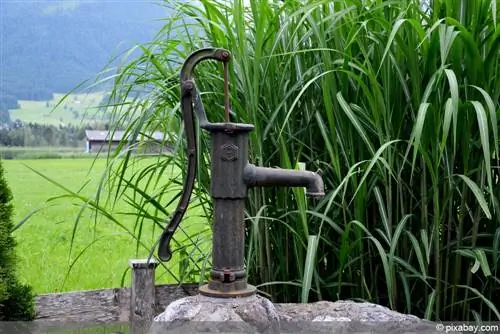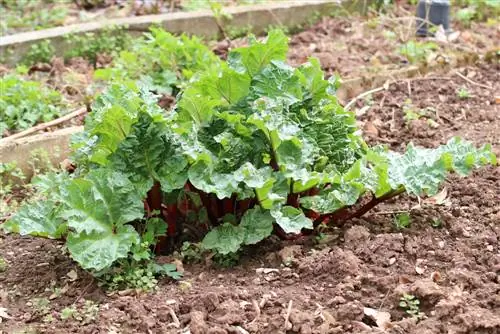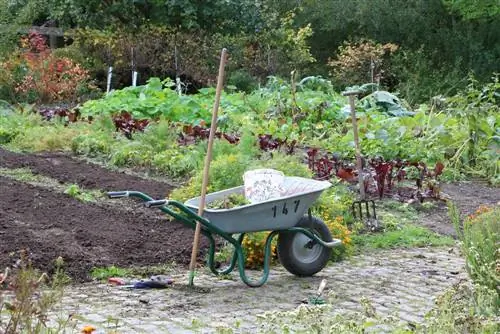- Author admin [email protected].
- Public 2023-12-17 03:39.
- Last modified 2025-01-24 12:45.
Behind the somewhat old-fashioned-sounding term water catchment there is a collective term that includes different structural measures for obtaining water. The water is usually obtained from layers of earth that contain groundwater, but can also come from springs. A deep well is just one of the possible forms of water collection. Anyone planning to install a fountain in their garden or on their weekend property should first familiarize themselves with the local conditions and legal regulations.
Considerations
If you decide to build a well in your own garden, you first have to find out at what depth the groundwater actually lies. After determining the water level, it is decided which type of fountain will be used.
- Rammwell, impact well (catching water by ramming, water depth up to 7 meters)
- Bore wells (acquiring water by drilling, water depth well below 7 meters)
Deepwell
As the name suggests, a deep well involves drilling into deep layers of water. In many cases, this undertaking requires expert support. Professionals bring with them both the necessary specialist knowledge and the necessary equipment. Deep wells below a water depth of seven meters are generally not intended for irrigating a small garden area.
Permits
Basically, “hitting a well” (regardless of whether it is used to supply gardens or utility areas) must be reported to the responsible water authority. Because: When building a well, you have to drill into the groundwater. This poses the risk of having a significant impact on the groundwater level. The display checks whether, depending on the depth of the well
- a water authority permit
- a water authority permit
will be required. There may also be other reasons against building a well, such as contaminated sites or a water protection area in the soil area in question. Depending on the municipality, the requirements for approval vary. For example, in Berlin, a deep well of up to 15 meters that does not produce more than 6000 m³ annually only requires notification and does not require approval. Therefore, you should definitely ask the authorities in advance.
Who can build a well?
In many communities/cities, a well that requires a permit may only be built by a well construction company! Impact or ramming wells, which only require notification, can also be dug with a self-assembly kit up to a depth of around seven meters and suitable ground conditions.
Costs and materials for a well
A percussion or ramming well can be built to a water depth of 6-7 meters if the soil conditions are loose and sandy. This type of deep well can be built relatively inexpensively using a do-it-yourself kit from a well-stocked hardware store. Drinking water cannot be obtained from wells, but they are nevertheless ideal for watering gardens or as domestic water for holiday homes. You need:
- Ramming well set (ramming filter with internal braid, well construction pipes 7 m), sleeves, impact piece, check valve): about 150 euros
- Well drill (earth drill with drill head, 6 m long): about 80 euros
- Hemp (for sealing): about 5 euros
- Fermit (sealant, permanently elastic): about 6 euros
- Handle pump: from 50 euros
- Flushing sleeve: about 9 euros
- Total costs: 300 euros (plus permit costs and equipment rental fee)
Tip:
When buying an electric pump, pay attention to the maximum delivery head!
Create a well
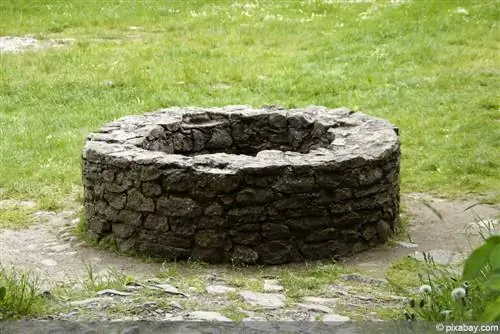
A percussion well is constructed using a steel pipe that has a pointed end. There is a ramming well filter at the top. The steel pipe is rammed into the earth until the water-bearing layer is reached. The construction of a ram well depends heavily on the local soil conditions. In very loose soil, deep wells with a maximum depth of 6-7 meters are possible with this variant. The water is extracted via a pump. This is connected to the top of the steel pipe and can be operated either manually or electrically.
Construction
Once the water depth is known, the soil conditions have been checked and approval has been obtained, construction of the ramming well can begin. The auger is now slowly turned into the earth at a suitable location.
Drilling a hole for the deep well
Before the water can be removed, a borehole must of course first be drilled to the water-bearing layer in the ground.
- Always turn slowly by hand
- the drill must not be overloaded
- never hit the drill or operate it mechanically
- always pull out and empty after two to three turns
- If you encounter impenetrable rock, it is better to drill a new hole
If you encounter damp ground after a few meters while drilling, the bottom of the hole is slightly closed again or water is even pushed up through the drill hole, the water-bearing layer has been reached.
Screwing pipes together
Now comes the challenging part of building a well: the pieces of pipe must now be connected to each other, sealed and hammered into the ground.
- Ramming filter and pipes (screw together along the length of the pre-drilled hole)
- carefully seal each thread on the steel pipe with hemp and fermite
- the threads may only be visible in the beginning
- screw two pipes together with a socket
- Screw in so far that the pipes in the socket meet on the inside
- good pipe wrenches are worth their weight in gold at work
Tip:
The weakest point when ramming (hammering in) the screwed-together pipe are the threads, which can be easily damaged. The impact force is only distributed evenly if the screws are screwed correctly.
Break in steel pipe
The pre-built pipe is now (as far as possible) inserted into the borehole (with the filter facing down). In order to protect the thread of the upper steel pipe, the impact head should be screwed onto the thread as far as it will go with each new pipe that is attached to the top. Pipe by pipe is then placed, sealed and hammered into the ground. This works best with an electric ramer, which can be borrowed from a tool rental store (hardware store). Alternatively, the pipe can also be driven in manually.
- Insert pipe into the hole
- Screw on the impact head
- Carefully drive in with an electric ram until just above ground level
- alternatively, hit manually (several medium-hard, centrally placed hits)
- Caution: using brute force may destroy the thread
- Aim: the pipe should penetrate at least one meter into the groundwater layer
- otherwise the pump will draw air when the groundwater level fluctuates
Connect pump
Once the desired depth has been reached, any dirt in the pipe (such as sand) must first be removed.
- Insert the garden hose all the way down into the pipe and flush up the sand
- Assembling the flushing sleeve
- Backwash for about 5-10 minutes (removes dirt from the filter opening)
- First install the handle pump without a check valve
- Pump out at intervals (10-15 minutes) until the water is clear
- Install check valve (carefully seal thread)
- Reconnect pump
Tip:
Electric pumps often have the problem that they pull fine sand very quickly against the ram filter. This causes the filter to become clogged. In this case, the pump should initially only be switched on at very short intervals. Water pumping can then be gradually extended.
Costs for approval
The fees for the deep well permit can vary depending on the municipality. On average, it can be expected that the following costs will be charged:
- about 40 euros for the ad
- Fee depending on the construction costs for the well
- possible fee for exemption from any bans for water protection areas
Costs according to groundwater depth
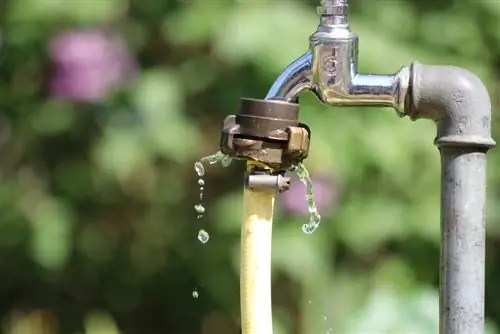
However, if the groundwater is very deep, there is no alternative to drilling a well. The well pipe is inserted into the ground using a combined flushing and drilling process. A pump pushes the water from bottom to top. These deep wells require a permit, although the permit is only granted by the issuing authority in rare exceptional cases. In addition, a well construction company (usually with a certificate) must carry out the construction. An undertaking where costs can quickly explode.
- Deep well up to 7 m: around 500-2000 euros
- Deep wells up to 20 m: around 15,000-20,000 euros
- Deep well 150 m: around 200,000 euros
Conclusion
Before building a deep well, local conditions and legal regulations must be checked. If the groundwater level is around five to seven meters below ground level, a self-built percussion or ram well can be a cheap option. If the ground conditions are suitable (relatively loose), a deep well can be built for around 500 euros.

